
|
Sale 46
The Millennia Collection
| Lot |
Photo |
Description |
Realized |
Lot 1073 |
 |
Mexico. 8 Reales, No Date-M (Mexico City, c. 1535-6); Assayer R (Francisco del Rincon). KM--; WR --. Carlos & Joanna, 1516-1556. Prior to Early Coinage (1538-1541) issues. Crowned arms of Castille and Leon; gothic-style mintmark. Reverse: Crowned pillars, rhomboidal panel containing PLVS; above and between pillars, a circular incuse with cross potent within; assayer mark below, Latin-style R. Bold, well-centered strike on nearly round flan. Spots of minimal weakness; areas of contact corrosion limited mostly to one edge of both sides. Toned. Excessively Rare -- one of only 3 specimens known.
Of the highest significance for the history of New World coinage. Emphasizing the experimental nature of this issue, one can discern that this coin is a test strike. Apparent in the fields are flattened designs, indicating that the present piece was overstruck on itself at least once, if not two or more times! NGC graded EF-40.
Carlos and Joanna, or Johanna, issued the first coins from Europe for the New World. Johanna was the daughter of Ferdinand and Isabella, and heir to the Spanish throne. She married Philip the Handsome, and they had a son named Charles. Both Johanna's mother, Isabella, and her husband, Philip, died young. By all reports this made Johanna mentally unbalanced. Her son claimed co-regency with Johanna, and had her imprisoned in the castle of Tordesilla. He then ruled in name with her, but effectively he ruled alone. So much for filial love.
Only 3 pieces were found in a shipwreck. One is held by a collector who wants one million dollars for his example. Another brought $373,750 at a Heritage sale last year at New York. The salvage group that found the shipwreck, and who at one time had all three coins in their possession, consigned it. The winning bidder, a well-known Latin-American collector, was prepared to pay much more for this coin. At the time of the sale, there were rumors of many more known examples; thus, many major buyers did not attend the sale or bid on this important coin.
Mr. Daniel Sedwick, who represented the salvage group at the sale, stated that this was the last piece from the shipwreck. Since the auction, it is now confirmed that only three of these coins are known. The discovery specimen is being offered here.
Estimated Value $200,000 - 250,000.
Illustrated in Money of the World, coin 144.
View details and enlarged photos
| Realized
$310,500 |
Lot 1074 |
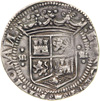 |
Mexico. 4 Reales, No Date-M-M (Mexico City); Assayer R (Francisco del Rincon). KM-0016; Cayon-3122. 13.55 grams. Carlos & Joanna, 1516-1556. Early Coinage (1538-1541); small central design. Crowned arms of Castille and Leon; gothic-style mintmarks. Reverse: Crowned pillars, value between, rhomboidal panel; assayer mark below. Cleanly struck on lightly oval flan. Some trivial edge weakness. Handsome old toning. Extremely Rare.
Probable date struck, late 1538. Of special note, this type, with Assayer R, and the rhomboid panel (plain, without dots), and the overall die style, closely corresponds to the Assayer R, Eight Reales struck at this same period. NGC graded AU-50.
Mexico City was the first Spanish mint established in the New World. Cortez, the conquistador of Mexico, as early as 1525, four years after the conquest petitioned Spain for a mint. Ten years later, in 1535, Antonio de Mendoza arrived in Mexico as the first Viceroy. He began almost immediately to mint coins. Two types of coins were produced, the earlier type with no waves on the obverse (1536-1542), and the later types with the obverse waves (1542-1572. The earlier type as offered here, is far rarer.
Estimated Value $7,000 - 8,000.
Ex Buddy de Silva Collection, Superior, 2/78, lot 1421. Calico no. 79 (plate coin). Ex F.C.C. Boyd Collection.
View details and enlarged photos
| Realized
$6,613 |
Lot 1075 |
 |
Mexico. 4 Reales, No Date-M-M (Mexico City); Assayer R (Francisco del Rincon). KM-0016; Cayon-3122. 13.57 grams. Carlos & Joanna, 1516-1556. Early Coinage (1538-1541); large central design. Crowned arms of Castille and Leon; gothic-style mintmarks. Reverse: Crowned pillars, value between, rounded panel; assayer mark below. Well centered, on very round flan. Some trivial doubling and edge weakness. Handsome old toning. Very Rare. Exceptional specimen with choice eye appeal.
Probable date struck, 1538. NGC graded AU-50.
The coins of Carlos and Johanna are undated, but the meticulous records of the Spanish enable us to match the assayers' initials with the dates of their employment. Thus, we can pretty much determine the dates of the coinage.
Estimated Value $7,000 - 8,000.
Ex S. Sadi Collection; ex F. Birardi Collection. Ex F.C.C. Boyd Collection.
View details and enlarged photos
| Realized
$6,613 |
Lot 1076 |
 |
Mexico. 4 Reales, No Date-M-M (Mexico City); Assayer R (Francisco del Rincon). KM-0016; Cayon-3122; Nesmith-6a. 13.54 grams. Carlos & Joanna, 1516-1556. Early Coinage (1538-1541); small central design. Crowned arms of Castille and Leon; gothic-style mintmarks. Reverse: Crowned pillars, value between, rounded panel; assayer mark below. Well centered and struck, on choice metal. Perfectly centered, on fairly round flan. Artistic old toning. Very Rare. Among the finest known.
Probable date struck, 1538. NGC graded EF-45.
Of interest here is the meaning of the two pillars pictured on the reverse. These symbolized the "Pillars of Hercules", or modern day Gibraltar. Gibraltar is an island that was owned by Spain at the time, and is located just a few feet off the Spanish coast. In 1704, during the War of the Spanish Succession, British troops conquered Gibraltar. British ownership was confirmed by the Treaty of Utrecht, which ended the war. Britain has owned the island ever since, and Spain has always wanted it back.
Estimated Value $7,000 - 8,000.
Ex Munoz Collection, Superior, 6/74 lot 2109; Arte de la Plata Mexicana, no. 6 (plate coin). Ex F.C.C. Boyd Collection.
View details and enlarged photos
| Realized
$6,613 |
Lot 1077 |
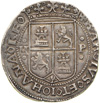 |
Mexico. 4 Reales, No Date-oMo-oPo (Mexico City, Assayer "P"). KM-0017; Cayon-3117. 13.59 grams. Carlos & Joanna, 1516-1556. Early Coinage (1538-1541); small central design. Crowned arms of Castille and Leon. Reverse: Crowned pillars, value between, rhomboidal panel with rightward slant with circles (without assayer mark). Choice sharp strike on lightly oval flan. Handsome old collection toning. Very Rare.
Probably date struck, late 1538-1540, or 1541. NGC graded AU-50.
Estimated Value $7,000 - 8,000.
Ex Ruby Collection, Superior, 7/78 lot 17; Grove, no. 25 (plate coin); Ex H.L. Freeman Collection; Nesmith no. 26a (plate coin). Ex F.C.C. Boyd Collection.
View details and enlarged photos
| Realized
$6,613 |
Lot 1078 |
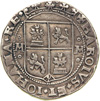 |
Mexico. 4 Reales, No Date-oMo-oMo (Mexico City); Assayer G (Juan Gutierrez). KM-0017; Cayon-3101. 13.47 grams. Carlos & Joanna, 1516-1556. Early Coinage (1538-1541); small central design. Crowned arms of Castille and Leon. Reverse: Crowned pillars, value between, rhomboidal panel with leftward slant with circles; assayer mark below. Clean, sharp strike on fairly round flan. Handsome old collection toning. Very Rare.
Probably date struck, late 1541-1542. NGC graded EF-45.
Estimated Value $7,000 - 8,000.
H.F. Burzio, Diccionario de la Moneda Hispano-Americana, no. 367 (plate coin); Nesmith no. 11 (plate coin); Calico, no. 80 plate coin); Crove, no. 12 plate coin); plate coin); Arte de la Plata Mexicana, no. 17 (plate coin); Ex Celso Isla, Galerie des Monnaies, New York, 2/80, lot no. 1110. Ex F.C.C. Boyd Collection.
View details and enlarged photos
| Realized
$6,613 |
Lot 1079 |
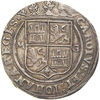 |
Mexico. 4 Reales, No Date-M-G (Mexico City). KM-0018; Cayon-3103. 13.67 grams. Carlos & Joanna, 1516-1556. Late Coinage (1542-1555); small central design. Crowned arms of Castille and Leon. Reverse: Crowned pillars over waves, motto between; value below. Choice sharp strike, perfectly centered on round flan. Some trivial peripheral weakness. Very fine old collection toning. Scarce this nice.
Assayer: Juan Gutierrez. Probable date struck, late 1542-1543, and again 1544-1545. NGC graded MS-61.
The care obviously taken in the minting of these coins is most impressive. Hammered sheets of silver were used from which the coin blanks were cut. The coins were then hand struck by placing the blanks between the dies and striking it with a hammer. This produced, round, fuly struck examples. Exceptionally beautiful for the time.
Estimated Value $700 - 900.
Ex F.C.C. Boyd Collection.
View details and enlarged photos
| Realized
$2,070 |
Lot 1080 |
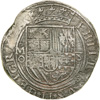 |
Mexico. 8 Reales, N.D. oMO (Mexico City), Flat Top 8; assayer O. WR-1 (round top 8); KM-43; Cal-244a; Calb - (unlisted variety). 26.92 grams. Philip II, 1556-1598. Retrograde D in Dei. Crowned Hapsburg shield.Reverse: Quartered arms of Castille and Leon in tressure. An especially good strike for type, with only modest weakness on reverse. Flan quite round, with handsome toning. Certainly among the finer known. NGC graded AU-50.
This coin figures as WR-1 in Wayte Raymond's The Silver Dollars of North and South America. At that time it was the only assured earliest dollar from the Mexico mint, and so of great significance for the numismatic history. The Rincon trial 8 Reales were only myth and rumor. However, with the discovery of the Rincon issue, lot 1073 in this collection, this coin steps from its pedastled position to something perhaps better than a footnote, since the flat top 8 is a rarer variety.
Estimated Value $8,000 - 10,000.
Ex F.C.C. Boyd Collection. Ex Superior A.N.A Sale, August 1975, lot 1932.
View details and enlarged photos
| Realized
$8,338 |
Lot 1081 |
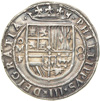 |
Mexico. "Royal" 8 Reales, No Date-MO-F (Mexico City). WR-2; KM-44.1. 27.38 grams. Philip III, 1598-1621. Crowned Hapsburg shield. Reverse: Cross quartering arms of Castille and Leon, within tressure. Exceptional strike on choice metal. Perfectly centered, on very round flan. Lovely gold and russet toning. Extremely Rare. The finest known. NGC graded AU-58.
Philip III was the son of the very powerful Philip II, but he took no interest in affairs of state and left all decisions to his favorite, the Duke of Lerma (1598-1618) and then to the Duke of Uceda, Lerma's son. Philip had a reputation for extreme piety. Under the influence of Lerma, he decreed that all Moriscos (Moors who had converted to Christianity after the Christian reconquest which ended in 1492) should be expelled from Spain. This was an economic disaster, for the Moriscos were one of the few groups in Spain that did not consider work beneath them. Being in trade was not even a consideration for Spainish nobles; they were much too grand to work with their hands, and the peasants worked the nobles' lands and had no power whatsoever. The Jews had played a major role as a "middle class" in Spain, but they were expelled in 1492 by Ferdinand and Isabella. Now, in 1609, the Moriscos, who were very important to Spanish agriculture, trade, and industries, were also expelled. By practicing "ethnic cleansing," Spain hastened its own decline.
The "Royals" were struck on specially selected, round planchets with special dies - the dies not necessarily having the same designs and inscriptions as those coins of the same date and mintmark in the regular coinage. Some of the better specimens may have well been sent to Spain so that the king could see for himself what fine handiwork was being done at the various mints.
Estimated Value $40,000 - 50,000.
Illustrated in Money of the World, coin 146; Ex: Calico.
View details and enlarged photos
| Realized
$57,500 |
Lot 1082 |
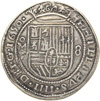 |
Mexico. "Royal" 8 Reales, 1650-M0-P (Mexico City). WR-3; KM-45. 26.73 grams. Philip IV, 1621-1665. Crowned Hapsburg shield. Reverse: Cross quartering arms of Castille and Leon, within tressure. Exceptional strike on choice metal. Perfectly centered, on quite round flan. Handsome gray toning, a deep gold and russet in the recesses. Extremely Rare - the rarest of the "Royals." The finest known. NGC graded EF-45.
Estimated Value $60,000 - 80,000.
View details and enlarged photos
| Realized
$92,000 |
Lot 1083 |
 |
Mexico. "Royal" 8 Escudos, 1714-Mo-J. Fr --; cf. KM World Coins, 1700-1800, p. 753; Grove 888. 26.94 grams Philip V, 1700-1746. Crowned arms, value of VIII in field. Reverse: Cross within quadrilobe, angled scepters. Trivial planchet flaw below date, otherwise remarkable centering and strike. Excessively rare. One of the finest known examples. NGC graded MS-65.
This coin the plate coin in Krause, Mishler, et al., Standard Catalogue of World Gold Coins, Fourth Edition, Iola, Wisconsin 20000; "Mexico," p. 756.
Combined in this coin is the "classic" Spanish, and Spanish colonial gold coin. The usual idea of Mexico's "treasure" coins are the crudely struck, thin-flan early coins, or the slightly later, and truly wretched "cob" coinage of the 17th and 18th centuries. Here one sees what a coin from a mineral-rich realm, belonging to a still-significant world power, should look like. Impersonal, and "anonymous," in that there are no portraits displayed, the insignia-laden shield bespeaks of ancient tradition and royal bearing, the large cross implies divine right, and above all, the coin's size and material speak most emphatically of power.
Spain had started making milled coins in 1586, beginning with the Segovia mint, and then off and on with varying quality. By the end of the 17th century, a major portion was being mechanically struck. Such was not the case with the colonies. In Mexico, it wasn't until the 1730's that milled coinage became a regular feature. Thus the "royal," or presentation strikes. These were struck on specially selected, round planchets with special dies - the dies not necessarily having the same designs and inscriptions as those coins of the same date and mintmark in the regular coinage. Some of the better specimens may have well been sent to Spain so that the king could see for himself what fine handiwork was being done at the various mints. On the other hand, for this issue there might be another reason. In 1714 Philip V, who was the first Bourbon king of Spain and a grandson of Louis XIV of France, married the ambitious and strong-willed Elizabeth Farnese as his second consort and queen. Coins such as these might have been among the gifts from the various colonial government seats that were assuredly bestowed on the "happy" newly-wed couple.
Estimated Value $100,000 - 125,000.
Illustrated in Money of the World, coin 148; Ex: Calico.
View details and enlarged photos
| Realized
$310,500 |
Lot 1084 |
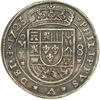 |
Mexico. "Royal" 8 Reales, 1723-MO-J. WR-5; KM-47. 26.85 grams. Philip V, 1700-1746. Crowned Bourbon shield. Reverse: Cross quartering arms of Castile and Leon, within foliated tressure. Extraordinarily sharp, full strike on superb metal. Perfectly centered, on fully round flan. Artistic toning, with hints of colorful golds, russets, greens and steel blues. Extremely Rare. A marvelous example, perhaps the finest "Royal" of any Spanish king! Superb. NGC graded AU-58.
Philip V was the first Bourbon king of Spain. He was a Frenchman, formerly Duke of Anjou, and a grandson of Louis XIV. Chosen by the childless Charles II to succeed him, Philip was king of Spain from 1700-1746; he abdicated in January 1724 in favor of his son Louis, but when Louis died in August of the same year, Philip took the throne again. He introduced French ideas and institutions to the Spanish court and and was much influenced by both of his wives, Maria Luisa of Savoy (1701) and Isabella (Elizabeth) Farnese of Parma (1714). Isabella took complete control of her husband's policies and was, in turn, dominated by the chief minister, Cardinal Alberoni. The attempt by the queen and Alberoni to regain the territories in Italy lost by the Treaty of Utrecht led to the formation of the Quadruple Alliance of 1718, to which Spain was forced to submit in 1720. Much of Spain's foreign policy was governed by dynastic ambition. In the War of the Polish Succession (1733-35), Naples and Sicily passed to Isabella and Philip's son, Don Carlos (later Charles III of Spain); in the War of the Austrian Succession (1740-48) Parma and Piacenza passed to Charles' younger brother Philip. Under Philip V, Spain began to recover from its economic stagnation, especially after Ensenada became chief minister in 1743 and virtually ruled the country. Ensenada tried to maintain peace and to regain Spanish independence through neutrality to both French and British policies. He instigated economic, fiscal, and administrative reforms which benefited the country. It was in large measure due to Ensenada that Philip was considered an "enlightened despot."
The "Royals" were struck on specially selected, round planchets with special dies - the dies not necessarily having the same designs and inscriptions as those coins of the same date and mintmark in the regular coinage. Some of the better specimens may have well been sent to Spain so that the king could see for himself what fine handiwork was being done at the various mints.
Estimated Value $40,000 - 50,000.
Illustrated in Money of the World, coin 149; Ex: 1975 ANA sale; Ex: F.C.C. Boyd collection.
View details and enlarged photos
| Realized
$57,500 |
Lot 1085 |
 |
Mexico. 8 Reales, 1732-Mo-F. Eliz-1; KM-103. 26.59 grams. Pillar coinage. Philip V, 1700-1746. Choice surfaces for grade, with a trace of luster, and lovely medium gray toning. Extremely Rare first year of issue. NGC graded AU-58.
The Pillar Coinage reflects a design change to indicate the start of solely mechanized coin production in Spain's New World mints. Mexico City's operations were earliest among the associated mints, beginning its milled coinage in 1732. The minting was such that the date is scarce to rare in all denominations, more so in the higher value reales.
Estimated Value $25,000 - 30,000.
Illustrated in Money of the World, coin 151.
View details and enlarged photos
| Realized
$46,000 |
Lot 1086 |
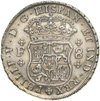 |
Mexico. 8 Reales, 1733 M.X-F. Eliz-5; WR-7; KM-103. 26.65 grams. Philip V, 1700-1746. Pillar Coinage. Crowned Bourbon arms. Reverse: Crowned globes flanked by crowned and bannered pillars, over water. Splendid crisp, full strike. Softly lustrous, with handsome medium gray toning, tending to iridescent blues, russets, and golds. Extremely Rare - the "MX" mintmark is rarest of the 1733 pillars. NGC graded MS-63.
The Bourbon kings ruled France from the time of Henry IV in 1589, until the French Revolution in 1792. Philip V, a Bourbon and grandson of king Louis XIV, was offered the Spanish throne. After a fourteen year war, Philip could rule Spain, but he and his heirs had to renounce the French crown. Thus the Bourbon arms on the Pillar Dollars.
Estimated Value $25,000 - 30,000.
View details and enlarged photos
| Realized
$40,250 |
Lot 1087 |
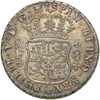 |
Mexico. 8 Reales, 1733 Mo-MF. Eliz-3; WR-7; KM-103. 27.02 grams. Philip V, 1700-1746. Pillar coinage, with smaller crown over globes. Crowned Bourbon arms. Reverse: Crowned globes flanked by crowned and bannered pillars, over water. Especially bold strike. Brilliant proof-like fields, with lustrous devices. With superb smoky toning, resplendent with iridescent colors of blues, greens, magentas, violets, and deep red-golds. This is the finest known small crown type. NGC graded MS-65.
Estimated Value $15,000 - 20,000.
Ex Patterson Collection.
View details and enlarged photos
| Realized
$37,950 |
Lot 1088 |
 |
Mexico. 8 Reales, 1733-Mo-F. Eliz-6; WR-7; KM-103. Pillar coinage. Philip V, 1700-1746. Trace of peripheral roughness one side of reverse, otherwise choice mint surfaces and luster, and well struck up centers. Fine dark gray toning, with hints of iridescent blue. Very Rare, and more so this choice.
Another example of Mexico City's earliest Pillar Dollars. For the 8 Reales, 1733, the second year of production, resulted in six different varieties - all very rare to excessively so. NGC graded MS-64.
Estimated Value $6,000 - 8,000.
View details and enlarged photos
| Realized
$18,400 |
Lot 1089 |
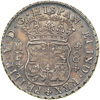 |
Mexico. 8 Reales, 1733 Mo-MF. Eliz-7; WR-7; KM-103. Philip V, 1700-1746. Pillar Coinage. Original surfaces with a trace of luster and lovely dark gray toning. Variety with large crown. Very Rare this choice. NGC graded MS-62.
When Spain "discovered" and subjugated the New World, it literally struck it rich! Vast quantities of gold and silver flowed back to her to be somewhat assimilated, creating for a while economic adjustments and disruptions that would eventually reverberate throughout most of Europe. Nevertheless, out of this arose the premiere "universal" coin of exchange, the silver 8 reales (or dollar, in the non-Spanish speaking world). In its four-century history, the coin maintained an unmatched record of fiduciary integrity, traveled to virtually every corner of the world, was the progenitor of numerous national currencies, and spawned a host of imitators. This is the second year of issue.
Estimated Value $5,000 - 6,000.
View details and enlarged photos
| Realized
$14,950 |
Lot 1090 |
 |
Mexico. 8 Reales, 1743-Mo-M.F. Eliz-20; KM-103. Philip V, 1700-1746. Pillar coinage. Excellent full, even strike. Old gray toning, with traces of vivid coloring towards the edges. Choice original surfaces, with considerable mint luster under toning. Scarce this nice. NGC graded MS-63.
An especially fine example of the standard silver coin of the realm, which circulated throughout the New World, and which was accepted as legal tender in the United States until 1850.
In the last decade of the 1600's, because of the rich gold strikes being made in Brazil, the abundant Portuguese gold filtering into Europe was again creating new and differing pressures on the gold to silver values, with concurrent effects, sometimes adverse, on the European economies. By contrast, the output of bullion, especially silver, from Spain's American colonies had dropped precipitously in the 17th century, due mainly to the mines playing out, which did not help one bit Spain's fiscal difficulties at home. However, the advent of new industrial processes was reversing this trend by the beginning of the 18th century, and, by the mid-century the silver workings were intensified to such a degree that output was higher than ever. Thus for Spain, while gold became a no-longer-dependable bullion income, subject to wide swings, the Spanish dollar, on the other hand, maintained its integrity and even expanded its role as an international, in fact an almost universal, medium of exchange. In North America, for example, at the end of the American Revolution, Spanish dollars outnumbered other coins by three or four to one. When the new United States decided that it should have its own uniform currency system, Thomas Jefferson suggested the Spanish dollar as the coin "most familiar of all to the mind of the people." A Congressional committee decided, with some modifications, in favor of Jefferson's proposal and recommended that the dollar would more likely "produce the happy effect of uniformity in counting money throughout the Union." In July 1785, Congress enacted that the money unit of the United States be the dollar.
Estimated Value $2,500 - 3,000.
View details and enlarged photos
| Realized
$3,680 |
Lot 1091 |
 |
Mexico. 8 Reales, 1749-Mo-M.F. Eliz-29; KM-104.1. Pillar coinage. Ferdinand VI. Pillar issue. Faint adjustment marks in center. Lustrous with frosty fields. Perhaps the finest known. NGC graded MS-66.
Despite wars and other vicissitudes of the 18th century, the commercial presence, and production, of American-made dollars remained unabated. Their international role now even extended into the orient. The mints were now mostly mechanized, producing rugged and large, well-made coins suitable for heavy use, or abuse. In addition, new industrial techniques allowed for an increase in production in the Mexican mines, and to a lesser extant those in Peru. The reigns of Ferdinand VI (1746-59) and Charles III (1759-88) saw monetary output reach new heights. Even so, much of it never went back to the mother country of Spain as it did in the old days. Dutch traders carted it off to the East Indies, and a great deal was drained out of Mexico directly to China, to pay for the rising standard of living that colonial populations were beginning to enjoy. Prosperity was on the increase worldwide, and dollar coins were a very visible instrument of it.
Estimated Value $2,500 - 3,000.
View details and enlarged photos
| Realized
$16,675 |
Lot 1092 |
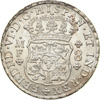 |
Mexico. 8 Reales, 1754 Mo-MF. Eliz-37; WR-9; KM-104.1. 27.11 grams. Ferdinand VI, 1746-1759. Pillar coinage, with Royal Crown on left pillar. Crowned Bourbon arms. Reverse: Crowned globes flanked by crowned and bannered pillars, over water. Crisp, bold strike with untouched original surfaces to fully display the cartwheel luster. Scarce. NGC graded MS-64.
Estimated Value $3,000 - 3,500.
Ex Sansores Collection.
View details and enlarged photos
| Realized
$6,900 |
Lot 1093 |
 |
Mexico. 8 Escudos, 1758 Mo-MM. Fr-21; KM-152. 26.99 grams. Ferdinand VI, 1746-1759. Third bust type, low relief. Draped and cuirassed bust of Ferdinand VI right. Reverse: Small crowned Bourbon arms within chain of the Order of the Golden Fleece. Bold, virtually fully struck centers. Proof-like fields. A choice example of type - flashy in appearance, with the most stylish of the Mexican portraits. Very rare in this grade. Considered one of the finest known. NGC graded MS-62.
Ferdinand was one of the few rulers who actually loved his wife. Maria Barbara of Braganza was his loyal and loving companion for 29 years. When she died in 1758, Ferdinand refused to dress or shave, and wandered around his park in a nightgown, refusing to conduct matters of state. He died almost exactly one year later.
Estimated Value $10,000 - 12,000.
View details and enlarged photos
| Realized
$21,850 |
Lot 1094 |
 |
Mexico. 8 Reales, 1759 Mo-MM. Eliz-47; WR-9; KM-104.2. Ferdinand VI, 1746-1759. Pillar coinage, with Imperial Crown on left pillar. Crowned Bourbon arms. Reverse: Crowned globes flanked by crowned and bannered pillars, over water. Crisp, fully detailed strike. Devices softly lustrous, the fields reflective. Lightly toned, tending towards a russet gray. NGC graded MS-62.
Estimated Value $1,200 - 1,500.
Ex Sansores Collection.
View details and enlarged photos
| Realized
$3,120 |
Lot 1095 |
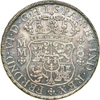 |
Mexico. 8 Reales, 1759-Mo-M.M. Eliz-47; WR-9; KM-104.2. Ferdinand VI. Pillar issue. Reflective fields with lovely peripheral toning. NGC graded MS-62.
English governmental, economic, and mercantile savants apparently noted that Spain, for all the precious metal that continued pouring into it from its New World colonies, still suffered economic difficulties. In the late 17th century, policies then in vogue in London's banking and economic circles strove to keep as much gold and silver specie in the country as possible, even if it meant restricting its outflow to her colonies. Commencing in 1695, England forbade the exportation of bullion to anywhere in the world, including its own colonies. As a result, the colonies in North America suffered constantly from coinage shortages. While token copper issues were made locally or imported, for silver they had to rely on other foreign currencies at hand, rather than England's familiar pounds, shillings, and pence. The closest country with the greatest supply was Mexico, which operated one of the world's largest mints. Thus, the money system that the Thirteen American Colonies grew attuned to for much of its commerce was that of Spain, rather than her own homeland. The largest of the Spanish silver coins bore the face value of eight Reales. These coins often were quartered, or cut into eights, to make small change. So while the Americans of the future United States rejected the use of the word Real for their monetary nomenclature, the use of the word eight stuck - these referring to "eight bits," or "pieces of eight." Even today, the term "two bits" still refers to a U.S. quarter.
Estimated Value $1,200 - 1,500.
View details and enlarged photos
| Realized
$3,105 |
Lot 1096 |
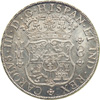 |
Mexico. 8 Reales, 1762 Mo-MM. Eliz-54; WR-10; KM-105. 27.21 grams. Charles III, 1759-1788. Pillar coinage. Crowned Bourbon arms. Reverse: Crowned globes flanked by crowned and bannered pillars, over water. Excellent even strike, with only trivial weakness at shield center. Satiny devices on reflective fields. Choice original surfaces and mint luster under light toning. Rare this nice. NGC graded MS-63.
Charles, although an ardent Catholic, objected strongly to what he perceived as excesses of the Church. He believed that the Jesuits were responsible for the disrupting riots of 1766, and had them banished from Spain. He quarreled with the Pope when he tried to reduce the numbers of the "Idle Clergy", and the monastic orders. He reduced the power of the Inquisition and rendered the organization relatively impotent. He was a significant modernizer of the state.
Estimated Value $1,400 - 1,600.
Ex Calbeto Collection.
View details and enlarged photos
| Realized
$4,370 |
Lot 1097 |
 |
Mexico. 8 Escudos, 1763-Mo-MM. Fr-29; KM 155. 27.04 grams. Carlos III. Bust right. Reverse: Crowned arms, Order of Golden Fleece around. Original luster and rare. NGC graded AU-58.
The son of Philip V and Elizabeth Farnese, Charles III was king of Spain from 1759-1788. A contemporary of Frederick the Great of Prussia, Louis XV and XVI of France, and Maria Theresa of Austria. Charles is regarded as one of the more "enlightened despots" of his time, and certainly the greatest of the Bourbon kings. His reign is noted for its administrative and economic reforms, and especially the expulsion of the Jesuits. He tried to keep Spain from getting pulled into the assorted nationalistic wars that never ceased to afflict Europe in the 18th century. Initially, during the Seven Years' War, Charles kept Spain neutral, only to come on in the end on France's side and share her defeat. From this Spain lost Florida to England, but on the other hand, by secret treaty with France acquired the latter's Louisiana territory.
Estimated Value $10,000 - 12,500.
Illustrated in Money of the World, coin 157.
View details and enlarged photos
| Realized
$27,600 |
Lot 1098 |
 |
Mexico. 8 Reales, 1779 Mo-F.F. Eliz-89; WR-11; KM-106.2. 26.99 grams. Charles III, 1759-1788. Laureate, draped, and cuirassed bust of Charles III right. Reverse: Crowned Bourbon arms, flanked by bannered pillars. Superbly struck, with glittering devices on reflective fields. Some faint harlines, othwerwise pristine surfaces. A superb coin. NGC graded MS-62 Prooflike.
During the 17th and 18th centuries the wealth that issued from Spain's New World mines was vast - almost beyond comprehension. In fact from 1500 through 1800, Bolivia, Peru and Mexico accounted for over 85 percent of the world's production and trade of silver. This huge resource helped to make Spanish coins the most commonly accepted currency in the world. The Spanish Real, or "royal," lives on today as the Rial in Oman and Yemen, and alternatively as the Riyal in Saudi Arabia. The Spanish Reales are also the basis on which most of the currencies of the English-speaking New World were originally based. In those countries, however, the already familiar word, Dollar, was preferred.
Estimated Value $1,500 - 2,000.
Ex Sansores Collection.
View details and enlarged photos
| Realized
$7,763 |
Lot 1099 |
 |
Mexico. 8 Reales, 1779-Mo-FF. Eliz-89; WR-11; KM-106.2. Charles III. Natural edge flaw and flat areas due to strike. Original luster with lovely golden toning. NGC graded MS-63.
The highest, most venerable and ancient families of Europe, through their long continued interbreeding (and inbreeding), began to take on some unusual physiognomic traits. Holy Roman Emperor, Leopold (1657-1705), called "hog-mouth," immediately comes to mind. The same was true for the Spanish and Portuguese rulers. This series has come down to us with nickname of the "rat-nose" issue. Coin lore has it that Charles, upon seeing this portrait for the first time, complained that his nose looked like that of a rat! Being extremely displeased, it is said that he had the engraver quietly assassinated.
Estimated Value $1,500 - 2,000.
View details and enlarged photos
| Realized
$3,680 |
Lot 1100 |
 |
Mexico. 8 Reales, 1789-Mo-F-M. (Mexico City). WR-12; KM-107. Charles IV, 1788-1808. "Imaginary" bust of Charles IV right. Reverse: Crowned arms between pillars. Slight weakness at cheek of portrait, otherwise finely struck and very lustrous. With slight toning. NGC graded MS-62.
Charles IV was dominated by his coarse and conniving wife, Maria Luisa of Parma. What was even worse, was that she had a lover, Manuel de Godoy, and this lover effectively took over control of the nation of Spain. What seems totally amazing is that Charles, who knew of the affair, kept Godoy as his friend and allowed him to govern the country.
Estimated Value $1,000 - 1,200.
View details and enlarged photos
| Realized
$1,380 |
Lot 1101 |
 |
Mexico. 8 Reales, 1790-Mo-F-M. (Mexico City). WR-12a; KM-108. Charles IV, 1788-1808. "Imaginary" bust of Charles IV right. Reverse: Crowned arms between pillars. Very slight weakness at cheek of portrait, otherwise finely struck and very lustrous. Fields prooflike, and lightly toned. NGC graded MS-60 Prooflike.
Estimated Value $1,000 - 1,200.
View details and enlarged photos
| Realized
$1,668 |
Lot 1102 |
 |
Mexico. 8 Reales, 1791 Mo-F.M. (Mexico City). Eliz-107; WR-13; KM-109. 27.03 grams. Charles IV, 1788-1808. Laureate, draped, and cuirassed bust of Charles IV right. Reverse: Crowned Bourbon arms, flanked by bannered pillars. Superbly struck, with lustrous cameo-like devices on reflective fields. Impressive pristine surfaces. A splendid example. NGC graded MS-65 Prooflike.
Estimated Value $2,000 - 2,500.
View details and enlarged photos
| Realized
$6,900 |
Lot 1103 |
 |
Mexico. 8 Escudos, 1799 Mo-FM (Mexico City). Fr-43; KM-159. 27.01 grams. Charles IV, 1788-1808. Draped and cuirassed bust of Charles IV right. Reverse: Crowned arms, Order of Golden Fleece around. Superior, even strike, on watery to satiny fields. Devices softly lustrous and cameo-like. Extraordinarily clean fields for these large gold coins. Very Rare in this grade, and undoubtedly one of the finest known. NGC graded MS-65.
Mexico City, the second largest city in the world today, has a long and important history. It was the capital of the Aztec Empire, and was then known as Tenochitlan. It was founded in 1325. It is situated at an altitude of 7,349 feet,which guaranties its mild climate. Mexico City is located on a small island, and the Aztecs had built numerrous causeways connecting the central island of the city to the shoreline. These causeways are the origin of the modern day calzedas which are some of the main avenues of the city today.
Estimated Value $5,000 - 6,000.
View details and enlarged photos
| Realized
$20,700 |
Lot 1104 |
 |
Mexico. 8 Reales, 1808-Mo-T.H. Eliz-135; KM-110. Ferdinand VII. Armored bust right. Deeply toned with much mint brilliance. NGC graded MS-64.
Circulated throughout the Americas as the standard silver coin of the realm. These were legal tender in the United States until 1850.
Estimated Value $800 - 900.
View details and enlarged photos
| Realized
$2,013 |
Lot 1105 |
 |
Mexico. 8 Reales, 1809 Mo-H.J. (Mexico City). Eliz-138; WR-14; KM-110. 26.93 grams. Ferdinand VII, 1808-1833. Laureate, draped, and cuirassed bust of Ferdinand VII right. Reverse: Crowned Bourbon arms, flanked by bannered pillars. Bold strike, with lustrous devices on reflective fields. Some trivial handling marks to portrait, otherwise a superb example. NGC graded MS-62.
This design is known as the military bust type, and was struck from 1808-1811. It was only issued for Mexico. It was an attempt to portray Ferdinand as a military leader. An attempt that failed badly, since he was captured by Napoleon and spent seven years in exile in France.
Estimated Value $800 - 900.
Ex Sansores Collection.
View details and enlarged photos
| Realized
$1,208 |
Lot 1106 |
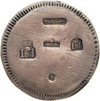 |
Mexico - War of Independence. Sombrerete 8 Reales, 1810 (Sombrerete Mint). Eliz-MX72; WR-24; KM-176. 26.99 grams. Royalist Coinage of General Vargas. Coin of Ferdinand VII, 1808-1833, overtstruck and countermarked. Two different countermarks with crowned S between pillars; horizontal stamps with date, 1810, and VARGAS; small stamp with "3". Reverse: Crowned Bourbon arms, inscription around. Finest example known. NGC graded EF-40.
Sombrerete, located in the province of Zacatecas, was an area of great mineral wealth. As the War for Independence spread, communications were so disrupted that the central government could no longer supply coin to the entire nation. Certain provincial mints were established to attempt to remedy the situation. One of these was established in Sombrerete under the royalist General Vargas. He was also administrator of the mines in the area. A great rarity.
Estimated Value $6,000 - 7,000.
Ex Sansores Collection.
View details and enlarged photos
| Realized
$10,063 |
Lot 1107 |
 |
Mexico - War of Independence. Insurgent Coinage. Zitacuaro 8 Reales, 1811. Eliz-MX120; Wr-36; KM-207. 22.96 grams. Struck coinage, under the Supreme National Congress of America. Crowned eagle atop cactus cluster, the whole over a bridge. Reverse: Hand clasping bow and arrow, spear, arrow, quiver and sling below. Some double striking apparent in obverse legends, otherwise fabulous quality for this struck coin. Of the highest rarity.
NGC graded AU-55.
Besides the plentiful Morelos issues, particularly in base metal, other insurgent leaders "melted or minted their own coins." Notable for both their importance and variety are those issued by the Zitacuaro Junta. A "Supreme National Junta" was established at Zitacuaro, Michoacán, on August 19, 1811 - apparently not wholly under the auspices of Morelos, since their coins carry an inscription of appeasement: "FERDIN. VII. DEI. GRATIA." Of singular importance with these issues is that the Mexican national emblem of an eagle, perched on a cactus plant, appears for the first time.
Estimated Value $40,000 - 50,000.
Illustrated in Money of the World, coin 161.
View details and enlarged photos
| Realized
$63,250 |
Lot 1108 |
 |
Mexico - War of Independence. Oaxaca Insurgent Coinage. 8 Reales, 1811. Eliz-MX113; WR-30; KM-234A. 23.74 grams. Struck coinage, under General Morelos. Bow and arrow over SUD, within cartouche of arabesques. Reverse: Monogram of Morelos over value and date, within cartouche of floral arabesques. Neater example of the typically very crude work, but with usual adjustment marks. Flaw on reverse flan, otherwise especially fine example of the silver "struck coin." Very Rare first year of issue. NGC graded EF-45.
Jose Maria Morelos was a follower of father Hidalgo, and also a Catholic priest. He attempted to lead the rebellion in the south. His objectives, land for the natives, redistribution of the wealth to the poor, and reforms of the clergy, never had a chance of succeeding. He was captured, and executed in 1815.
Estimated Value $3,000 - 3,500.
View details and enlarged photos
| Realized
$3,795 |
Lot 1109 |
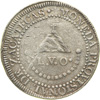 |
Mexico - Zacatecas. War of Independence. Royalist Coinage. 8 Reales, 1811. Eliz MX80 var.; WR --; KM-190 var. 27.80 grams. Ferdinand VII, 1808-1833. L.V.O., late series. Mountain above L.V.O., chain of rosettes below; cross on distant peak. Reverse: Crowned Bourbon arms, flanked by bannered pillars. Modest actual wear, and good surfaces for series. Lightly toned, with touches of iridescence. Very Rare error variety: Ferdinand VII misspelled as Ferdinand VI. NGC graded EF-40.
Estimated Value $2,500 - 3,000.
View details and enlarged photos
| Realized
$5,290 |
Lot 1110 |
 |
Mexico - War of Independence. Oaxaca Royalist Coinage. 8 Reales, 1812. Eliz --; WR-29 var.; Y-768; C-922; KM-168 var. 26.99 grams. Ferdinand VII, 1808-1833. Cast Royalist coinage of Lt. General Savaria. Large Lion variety. Voided cross, lion and castle at upper angles, F.o and 7.o at lower, three rosettes in field. Reverse: Large lion within shield with double border of eight X's; above, countermark of "ZEI," "ZEV," or "VE" monogram in square indent. Choice problem free surfaces, with handsome toning. Superior example of type, and Possibly Unique.
The photograph in Pradeau, pl. XIII, no. 4, reverse only, was taken from this coin. The illustrations for Y-768 and C-922 are copied from the Pradeau picture. Since these standard references use the photo of this specimen, and none of them mention that the reverse counterstamp is actually a monogram, but rather simply calling it a "V," it is quite probable that this coin is unique. NGC graded AU-55.
Estimated Value $12,500 - 15,000.
Ex Dr. Pradeau Collection. Pradeau Sale III, Superior, 11-71, lot 1562, realized $3250.
View details and enlarged photos
| Realized
$23,000 |
Lot 1111 |
 |
Mexico - War of Independence. Oaxaca Royalist Coinage. 8 Reales, 1812. Eliz-MX71; WR-29; Y--; C-923; KM-168. 26.98 grams. Ferdinand VII, 1808-1833. Cast Royalist coinage of Lt. General Savaria. Small Lion variety. Voided cross, lion and castle at upper angles, F.o and 7.o at lower, three rosettes in field; below 7, crowned O between two pillars, within arch-shaped indent. Reverse: Small lion within shield with double border of eight X's; above, countermark of "Z." in square indent. Choice problem free surfaces, with handsome toning. A very choice example of type. NGC graded MS-61.
Estimated Value $10,000 - 12,000.
Ex Dr. Pradeau Collection. Pradeau Sale III, Superior, 11-71, lot 1563, realized $2200.
View details and enlarged photos
| Realized
$17,250 |
Lot 1112 |
 |
Mexico. 8 Reales, 1819 Mo-J.J. (Mexico City). Eliz-160; WR-15; KM-111. 26.99 grams. Ferdinand VII, 1808-1833. Laureate and draped bust of Ferdinand VII right. Reverse: Crowned Bourbon arms, flanked by bannered pillars. Boldly struck, with lustrous to velvety devices on bright fields. Some trivial handling marks to portrait, otherwise a superb example. NGC graded MS-62.
Estimated Value $750 - 1,000.
Ex Sansores Collection.
View details and enlarged photos
| Realized
$1,840 |
Lot 1113 |
 |
Mexico - 8 Escudos, 1822-Mo-JM (Mexico City). Fr-59; Cr-188; KM 313.1. 26.99 grams. Empire of Iturbide. First portrait type. Bare head of General Augustine Iturbide right. Reverse: Crowned eagle atop cactus, Aztec arms around. Weakness at eagle, otherwise excellent strike for series. A few light marks. Very lustrous, with reflective fields. Very rare, particularly in this grade. One of the finest known examples. NGC graded MS-62.
Estimated Value $12,500 - 15,000.
Illustrated in Money of the World, coin 162.
View details and enlarged photos
| Realized
$28,750 |
Lot 1114 |
 |
Mexico. 8 Reales, 1822-Mo-JM (Mexico City). Buttrey-2B; Eliz-164; KM-306.2 (type I). 27.01 grams. Empire of Iturbide Large head, "AUGUST" type; value at upper edge. Bare head of General Augustine Iturbide right. Reverse: Crowned eagle atop cactus, value at 10 o'clock. Superior strike, the devices softly lustrous on reflective fields. Handling marks generally small, and thinly dispersed. NGC graded MS-61.
Augustin Iturbide was a man of his times, with certian beliefs and biases which led to his undoing. Originally a soldier of Spain, he fought first against the rebels, but later joined their cause. A man of principles, he believed in the righteousness of the revoulution, but he also tried to deal with the Spaniards with honor. He promised the departing Spaniards equal value in gold for their landholdings. This "honorable" settlement essentially bankrupted the new independent Mexico.
Estimated Value $4,000 - 5,000.
View details and enlarged photos
| Realized
$7,188 |
Lot 1115 |
 |
Mexico - 8 Reales, 1822-Mo-JM (Mexico City). Buttrey-3B; Eliz-165; KM-308 (type III). 27.09 grams. Empire of Iturbide. Large head, long truncation; "AUGUSTINUS" type; value at upper edge. Bare head of General Augustine Iturbide right. Reverse: Crowned eagle atop cactus, value at 10 o'clock. Eyes of portrait and body of eagle showing some flatness. Obverse field very reflective, the reverse mostly so at the peripheries. Medium deep toning, emphasizing blues, violets, and coppers on the obverse, with pinkish grays on the reverse.
This is one of the finest known examples of this one-year type. NGC graded AU-58.
Iturbide was a military man. The conservatives in the new, independent Mexico wanted a royal from Europe to head the country. When no royal would accept the position, these same conservatives persuaded Iturbide to become Emperor. He ruled the nation as if his citizens were soldiers. He imprisoned those who disagreed with him. Democratic principles were alien to him. The people wouldn't accept his autocratic methods and he was forced to abdicate and leave Mexico.
Estimated Value $6,000 - 7,000.
View details and enlarged photos
| Realized
$6,900 |
Lot 1116 |
 |
Mexico - 8 Reales, 1822-Mo-JM (Mexico City). Buttrey-3C; Eliz-166; KM-309 (type IV). 26.88 grams. Empire of Iturbide. Large head; value at lower edge. Bare head of General Augustine Iturbide right. Reverse: Crowned eagle atop cactus, value at 7 o'clock. Very good strike, the fields lustrous and quite clean. Medium toning on obverse, emphasizing blues and steely greens; the reverse darker, with rich coppers and russets. A very nice coin. One-year type. NGC graded MS-62.
Estimated Value $3,500 - 4,000.
View details and enlarged photos
| Realized
$6,038 |
Lot 1117 |
 |
Mexico - 8 Reales, 1822-Mo-JM (Mexico City). Buttrey-4C; Eliz-167; KM-310 (type V). 26.94 grams. Empire of Iturbide. Small head type. Bare head of General Augustine Iturbide right. Reverse: Crowned eagle atop cactus. Very good strike, with only trifling softness to centers -- striations in the face due to milling and rolling techniques used in making the flans. Brilliant and lustrous. A two-year type. NGC graded MS-63.
As part of the terms of Iturbide's exile, he was forbidden to ever return to Mexico. He went to Italy and then to Britain. Influenced by Napoleon's return from exile, and missing his native land, Iturbide decided to come back. He came back in 1824, landed in Soto la Marina. He was immediately arrested and soon after, shot.
Estimated Value $3,500 - 4,000.
View details and enlarged photos
| Realized
$6,613 |
Lot 1118 |
 |
Mexico. 8 Escudos, 1823-Mo-JM (Mexico City). Fr-60; KM 314. 26.99 grams. Empire of Iturbide. Second portrait type. Bare head of General Augustine Iturbide right. Reverse: Crowned eagle atop cactus in ornate oval escutcheon, Aztec arms below. A better strike, with less weakness at the centers, than is mostly seen in this series that suffered from inferior production technique. Minor faint adjustment lines, and a few light marks that are mostly confined to the devices. Very lustrous, with reflective fields. Very rare, particularly in this grade. One of the finest known examples. NGC graded MS-62.
Estimated Value $7,000 - 8,000.
View details and enlarged photos
| Realized
$14,375 |
Lot 1119 |
 |
Mexico - Republic. 8 Escudos, 1823-Mo-JM. Fr-63; KM 382.2. 27.01 grams. Type II: Hooknecked-eagle, left, holding looped snake. Reverse: Hand holding Liberty Cap on staff, over open book. Faint adjustment marks at hand, otherwise centers unusually well struck up. Fields very lustrous. Very rare, particularly in this grade. NGC graded MS-62.
The establishment of the United States, along with the ideas aroused by the French Revolution, augmented by the Napoleonic occupation of Spain, set in motion the pent up forces in Mexico on the course to independence. Begun by the priest Miguel Hildago y Costilla, whose rallying cry for racial equality and redistribution of land captured the hearts of the disenfranchised, the conflicts between Mexico's revolutionary and conservative factions spun out over several years. With a change of regime in Spain, in 1820, a way was found to negotiate a separation from her and Mexico. The Spanish colony became formally independent in 1821, but independence was modified by royalist elements, who voted Don Augustin I Iturbide in as emperor in 1822. Republican elements countered, pressing him to abdicate, which he did in 1823. Mexico was at last a republic.
This is the first gold coin to be issued by the new republic. Also, it is a single year type, with Mexico City being the only issuing mint. Struck in two varieties, the Type II's being much rarer than the Type I's. Smaller denominations of the Escudo wouldn't begin appearing until 1825, and only at a few mints.
Estimated Value $20,000 - 25,000.
Illustrated in Money of the World, coin 163.
View details and enlarged photos
| Realized
$48,300 |
Lot 1120 |
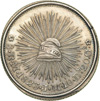 |
Mexico - Republic. Pattern 8 Reales, 1823-Mo-JM (Mexico City). Buttrey Pn-21 (plate coin); KM-Pn-3 (plate coin). 26.93 grams. Hooknecked-eagle, left, holding looped defiant snake. Reverse: Liberty Cap, rays behind. Herringbone edge. Superior strike. Light hairlines from ancient cleaning hidden under fine old toning - multi-colored but strongly russet on the obverse recesses, and more towards the blues on the reverse. NGC graded Proof 63.
Estimated Value $50,000 - 60,000.
Ex Porraz Collection. Possibly UNIQUE, and the only known specimen in private hands. The most significant crown of the Mexican Republic!
View details and enlarged photos
| Realized
$89,125 |
Lot 1121 |
 |
Mexico - Republic. 8 Reales, 1823-Mo-JM (Mexico City). WR-62; Eliz-179; KM-A376.2. 27.01 grams. Flat-topped 3. Hooknecked-eagle, left, holding looped snake. Reverse: Liberty Cap, rays behind. Laurel leaf edge. Bold strike, with brilliant fields and somewhat matte devices. Among the finest known. Toned.
First regular issue 8 Reales of the Mexican Republic. NGC graded MS-63.
Estimated Value $7,000 - 9,000.
View details and enlarged photos
| Realized
$18,400 |
Lot 1122 |
 |
Mexico - Republic. 8 Reales, 1824-Go-JM (Guanajuato). Eliz-176; KM-A376.1. 26.81 grams. Open snake type. Hooknecked-eagle, left, holding looped defiant snake. Reverse: Liberty Cap, rays behind. Good strike for this series -- the centers just a little soft, with evidence of clashing to reverse die. Choice surfaces; lustrous, with even medium toning. NGC graded MS-62.
Estimated Value $10,000 - 12,000.
Ex Antonio Karem Collection. This is the finest known example for this mint, and perhaps the only Mint State specimen of the type for Guanajuato.
View details and enlarged photos
| Realized
$14,950 |
|
|